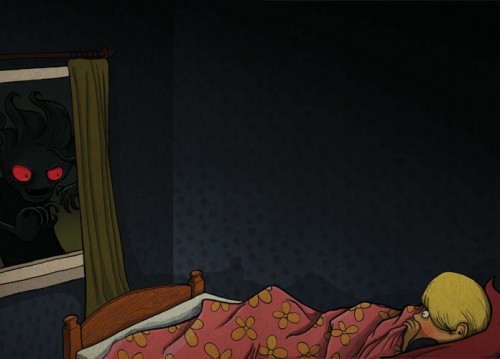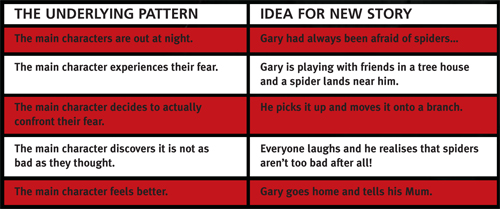Can your class write a tale of suspense after reading Pie Corbett's story about facing your fears?
Sally was afraid. At school, they called her the ‘fraidy girl’ because she seemed afraid of everything. But what she feared the most was the darkness. Every night she didn’t want to go upstairs to bed. She hung around in the kitchen making excuses. Anything to delay going up the stairs. Anything to delay the moment when the light was switched off, plunging her room into darkness.
One moment the room was bright; the next split second and the room was darker than jet. As her eyes adjusted, vague shapes swam into view. The chair in the corner looked like an old man crouching down, ready to leap at her. The dressing gown on the back of the door was like a thin man, leaning, waiting for her to sleep before he hobbled across the room towards her…
Sally lay in the darkness every night watching the old man and the thin man. Neither of them ever moved but she was sure that when she fell asleep they would be up and wandering round – peering at her sleeping face. But, more than anything, she feared the Nightmare Man.
Sally had seen him once, watching her through the window – a tall, dark shape with a cloak billowing out behind him and two red eyes that glowed. She had spent the rest of the night buried under the covers, waiting for dawn. Of course, she had told her mother but all she ever said was, ‘don’t be so silly’ or ‘hurry up and eat your breakfast’ or ‘not now, we’ll be late for school’. Since that night Sally made sure that her curtains were tightly pulled together.
 The night of the storm, Sally lay in her bed watching the old man and the thin man. Thunder grumbled in the distance. Lightning crackled. Rain lashed the street. Surely, the Nightmare Man wouldn’t be out on a night like this? Sally just had to know. Heart thudding, she crept from her bed and peeked through the curtains. She got the shock of her life because there he was, clinging to the window with his twin red eyes staring right at her.
The night of the storm, Sally lay in her bed watching the old man and the thin man. Thunder grumbled in the distance. Lightning crackled. Rain lashed the street. Surely, the Nightmare Man wouldn’t be out on a night like this? Sally just had to know. Heart thudding, she crept from her bed and peeked through the curtains. She got the shock of her life because there he was, clinging to the window with his twin red eyes staring right at her.
Sally stepped back but at that very moment the lightning flashed, lighting up the night sky. The Nightmare Man had gone but Sally could see a distant tower, a tower with two red lights. She also saw the tree by her window move in the wind, casting a dark shadow. In that moment, as the lightning lit up the night, she realised that the Nightmare Man had not really existed at all. Only in her mind. She laughed aloud…
Her bed seemed warm and cosy. She stared across her room, through the curtains at the distant lights of the tower and watched the tree’s shadow blowing in the wind. After that, the Nightmare Man never came back. Soon the thin man became a dressing gown and the old man was just a chair with her clothes draped across it, ready for the next morning, ready for the sunlight.
© Pie Corbett
Get a whiteboard-friendly version of Pie’s story…
If you would like to share this story with your class on the whiteboard, you can download a copy from the following website http://www.teachprimary.com/download/pie-corbett
The Nightmare Man is built around a simple story idea – ‘facing your fear’. Everyone is afraid of all sorts of things. Start by making a class list with the children – try to move them away from the clichés such as ‘Dracula’ and on to other sorts of fears. For their story they will need to choose something that their main character is afraid of. The character then has to face their fear and overcome it. By the end of the story, the main character is no longer so afraid – the fear has diminished.
Loiter with the story for at least two or three days, if not longer. This will help the less confident internalise the patterns. Make sure that they have heard the story being read and read it themselves as often as possible. Display it on the interactive whiteboard so that it can be seen by everyone. Deepen understanding with the following activities:
• Role play the conversation between Mum and Sally when Sally tries to tell her mum about her fears.
• Hot seat Mum and discuss Sally.
• Hot seat Sally before the story and after the story.
• Draw a character graph to show how Sally’s feelings change during the story – label the ups and downs with words and phrases from the story.
• Write a short description of night-time in your room, turning familiar objects into frightening images. Use a repeating phrase to help, e.g.
In the darkness a chair
Becomes a bear crouching.
In the darkness the curtains
Become dark wings rustling.
In the darkness the door
Becomes the entrance to the Minotaur’s lair.
Read the section where the storm is described. Write a similar description using similes. Mention the thunder, lightning, wind, stars, moon, clouds and rain, e.g.
On a stormy night,
thunder rumbles like a dreadful drum.
lightning hisses like an electric whip.
the wind shivers tree tops,
stars quiver like shivering sparks,
the moon hides its silver eye,
clouds billow like gigantic sails
and the rain glitters like fierce beads.
To help the children write a version of the story, try the following ideas:
• Start the story with this sort of opening, Gary had always been afraid of….
• Make sure the children choose a simple idea.
• In shared writing, show children how to build up the tension by slowing the action down.
• Use the senses to build up the fear rather then just saying, ‘He was scared’.
• Reveal what the character is feeling by using an ‘inside/outside’ sentence, e.g. Gary grinned at his friends but inside he was feeling scared.
• Make a list of what happens to our bodies when we are scared, e.g. trembling. Turn children’s ideas into possible sentences, e.g. Gary trembled. This will help to show the reader how the character feels rather than just ‘telling’.
• Remember to vary sentence openings and use this to show how a character feels, e.g.
Anxiously, he picked the spider up. Trembling, he carried it to the window. Amazed, he watched it crawl away.
I would begin by ‘boxing up’ the story to show the underlying pattern – you might like to do this paragraph by paragraph. This can then be used as a basis for a new version, e.g.

Teaching five year olds to talk
Ace-Classroom-Support
Behaviour management: choosing the right words
Behaviour Management
KS2 Lesson plan: China and Buddism
Ace-English
Use the bottle-flipping craze to create good school behaviour, not bad
Behaviour Management
